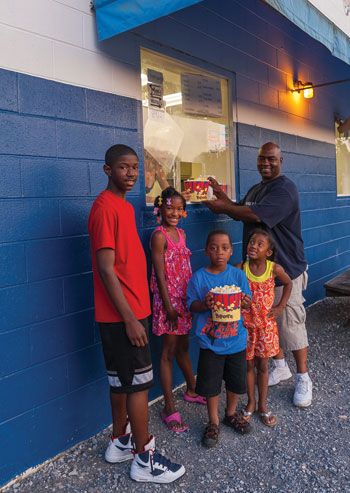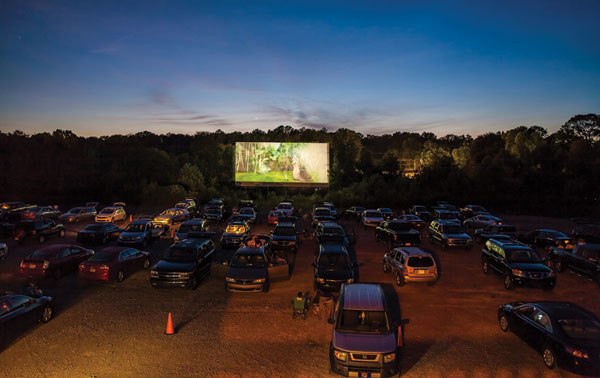
Argo Drive-In introducing a new
generation to an American movie tradition
Story by Elaine Hobson Miller
Photos by Michael Callahan
As a child growing up in north Alabama, Faye Riggs, 65, often went to the drive-in with her parents and sisters. They paid by the carload, with some money left over for snacks and drinks.
“We’d drive around until we found a speaker that worked, then Mom and Dad would sit on the hood of the car, while we girls played on the swings in front of the screen,” recalls Riggs, who now lives in Tallahassee, Florida. “They watched the movie and kept an eye on us at the same time. We kids loved being outdoors where we could run around and not get bored.”
Those were simpler times, before shopping malls and multiplex screens, before you had to sign away your birthright to pay for a night at the movies.
It was this affordability factor that motivated Brian Skinner to build the Argo Drive-In. At a church meeting, he and friends talked about the expense of going to the movies, and how much cheaper it had been to go to a drive-in. “That’s when the idea was born,” says Skinner, 51, owner of the Crawford and Skinner Insurance agency in Springville.
He tracked down a newspaper article he had read about a new drive-in on the West Coast, contacted the owner, and asked a lot of questions. He found 3 acres of undeveloped land on Angus Street, just off U.S. 11 in Argo. He got help from an elderly gentleman in Trussville who used to build billboards. “The screen is nothing but a giant billboard anyway,” Skinner says.
 His first feature, “Titanic,” drew 171 cars opening night, May 22, 1998. Back then, he showed movies seven nights a week, all year round, charging $10 per carload, except on Wednesdays, when the price dropped to $5. He was very successful. “We’d have mini-vans with five or six people in them,” Skinner recalls. “The public loved it.” The distributors didn’t. They said the carload pricing cheapened their product. So three years ago, Skinner was forced to transition to individual pricing to get the first-run movies he shows. Now open Fridays and Saturdays only, “the nights we can make some money,” he charges $5 per adult, $2 for children under 12, and nothing for children in car seats. He operates from early May through September, plus Thanksgiving and Christmas holidays, weather permitting. Sometimes, on a Thursday or Sunday night, someone will rent the theater for a church group, office party, birthday party or customer appreciation night.
His first feature, “Titanic,” drew 171 cars opening night, May 22, 1998. Back then, he showed movies seven nights a week, all year round, charging $10 per carload, except on Wednesdays, when the price dropped to $5. He was very successful. “We’d have mini-vans with five or six people in them,” Skinner recalls. “The public loved it.” The distributors didn’t. They said the carload pricing cheapened their product. So three years ago, Skinner was forced to transition to individual pricing to get the first-run movies he shows. Now open Fridays and Saturdays only, “the nights we can make some money,” he charges $5 per adult, $2 for children under 12, and nothing for children in car seats. He operates from early May through September, plus Thanksgiving and Christmas holidays, weather permitting. Sometimes, on a Thursday or Sunday night, someone will rent the theater for a church group, office party, birthday party or customer appreciation night.
Drive-ins were born 80 years ago in Camden, N.J., invented by Richard Hollingshead Jr., who capitalized on the success of drive-in restaurants. They became immensely popular because parents could take children in their pajamas and moms could leave their hair in curlers. Later, they became a hangout for teenagers, who could make out in cars without parental interference. Their popularity peaked in 1958 with almost 5,000 across the United States. Then televisions began popping up in every household, and shopping malls became teenage hangouts, throwing drive-ins into a slow, steady decline. As of March 13, 2013, there were 357 drive-ins with 604 screens (many are twinplexes) in the U.S., according to the United Drive-In Theatre Owners Association (UDITOA). The industry has seen several signs of growth over the past decade as families rediscover their affordable concessions and double-feature admissions.
Alabama has 10 drive-in sites with 16 screens, according to the UDITOA, including the three that Skinner owns — Argo, the Starlite in Anniston and a twinplex in Harpersville. The Starlite closed indefinitely when a storm flattened the screen last spring. That same storm twisted Argo’s marquee, but didn’t damage the 26-foot-by-60-foot screen. Made up of some 66 sheets of corrugated tin covered in a flat-enamel paint, it’s built tough, Skinner says.
Looking like a giant, gravel parking lot dotted with orange cones, Argo’s capacity is 175 cars if all are parked correctly, i.e., two between each set of cones. More can be accommodated if parked fender-to-fender, as they were for the theater’s 208-car viewing of “Dr. Doolittle,” starring Eddie Murphy. “That was a record-breaking night,” says Alex Bosworth, the 19-year-old Jefferson State Community College freshman who works the gate at Argo. “People were parked all along Angus Drive, up Highway 11, in the fields, everywhere. They were walking in carrying lawn chairs.”
Noticeably absent are the stands mounted with speakers that movie-goers used to pull into their cars — and often pulled off with. Gone, too, are their scratchy sounds, now that car radios and boom boxes pick up the movie’s audio from the small FM transmitter in the projection booth. “Today’s sound is as good as your radio,” says Skinner, who uses 89.1 on the FM dial.
A small, two-story cinderblock building at the back of the parking lot houses the concession stand on the first level, the projection booth on the second. Popcorn sells for $3 and $4 a bag, hot dogs for $2, soft drinks for $2 and $3. “A family of four can come in and have a good time on $20,” Skinner says.
In the projection booth, the 35 mm film whirs through the Cinemascope projector, which sends its beam through a tiny, stationary window pane toward the giant screen 275 feet away. The whirring sound comes from the fans that blow antifreeze over the 4,000-watt bulb to keep it cool. Three giant metal platters hold up to three hours of film, which comes in via UPS in 20-minute reels that must be spliced together, then taken apart before shipping out again. “One of the funniest things was when we spliced a movie out of sequence,” says Skinner. “Very few people knew it. My biggest worry was whether the credits were at the end!”
Argo caters to families, which make up 75 percent of its patrons. Looking through movie choices on his order form, perusing trade papers for ticket grosses, Skinner knows not to select anything intense. “Cartoons, comedies and action-adventure do best at a drive-in,” he says. Saturday nights draw the most cars, he adds, but people buy more food on Friday nights, when they come straight from work without dinner.
Showtime starts at dusk, usually around 8 p.m. One warm Friday night last summer, cars were backed up to Highway 11 when the gate opened at 7:30. More than 50 vehicles spread out across the lot, most parked with their rear-ends facing the screen, their tailgates down or their rear hatches propped up. Dressed in shorts and flip-flops, jeans and hospital scrubs, patrons set up lawn chairs in truck beds and on the ground, then tossed Frisbees and softballs before the movie started. These “ozoners,” as drive-in patrons were once called, came from St. Clair, Etowah, Jefferson and Shelby counties for the al-fresco viewing experience.
Nine-year-old Ashton Hutcherson, son of Cynthia and Robert Hutcherson of Argo and a student at Springville Elementary, loves propping up on pillows in the back of his family’s SUV, where he doesn’t have to peer over people’s heads to see the screen.
Karla Lowery and Kathy Arrington, sisters from Gadsden, have been to the Argo several times. They park close to the concession building to be near the bathrooms and so their smoking doesn’t bother anyone. This night, they brought along Karla’s kids,11-year-old Austin and 7-year-old Heather.
“We love it,” says Kathy. “You can have a conversation about the movie without disturbing the person next to you.” She doesn’t mind the trains that rumble through several times each night, passing so close behind the concession stand you can almost touch the box cars and tankers.
Amy Roy of Argo brought her son, Axel, 3, and daughter Chloe, 10, plus some friends from Hoover. “I had never been to a drive-in until we moved to Argo from Atlanta nine years ago,” she says. “My mom has been with us, and she went many times as a child and teen.”
After his 60-40 gate split with distributors, Skinner barely keeps his head above water at Argo. The industry is moving toward a digital format, and he prays that 35 mm film will be available for a few more years because the switch is expensive. He makes money at Harpersville, though, and reasons that Argo gives teenagers jobs and families a good time.
“It’s fun, and it gives me pleasure to see families here,” he says. “It’s very entertaining.”
















